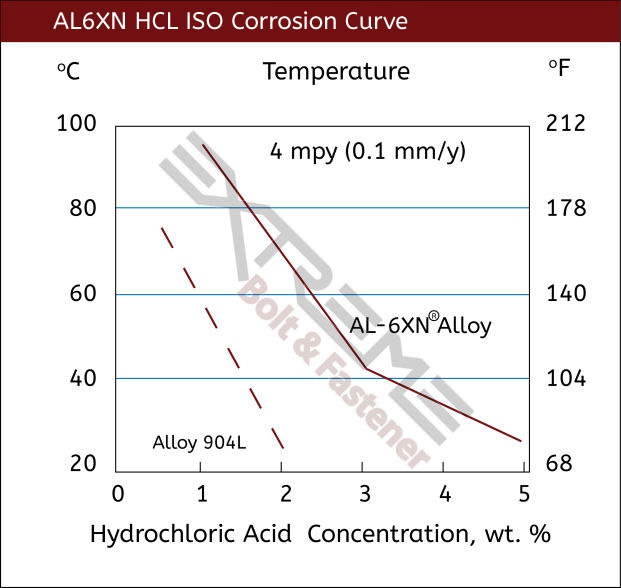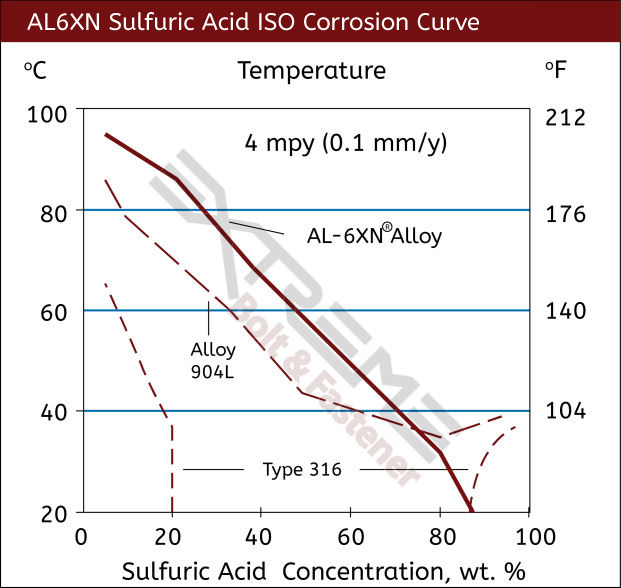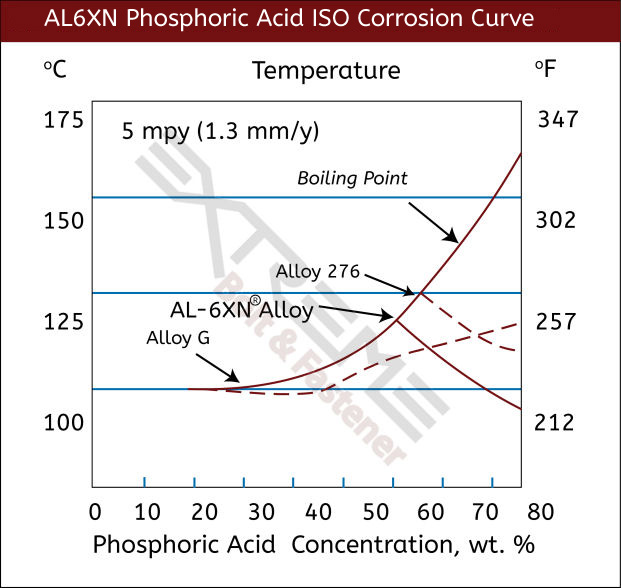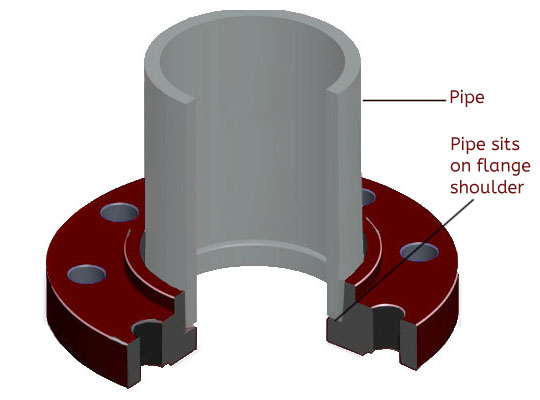A mid-ranged corrosion resistant 6Mo alloy with good strength
- Good corrosion resistance to moderate acids & sea-water
- 50% stronger than stainless steel
- Usable temperature limit of 1000°F
- AL6XN chemistry & specifications
- Socket weld flange features and benefits
- AL6XN Datasheet
Originally developed to combat sea water corrosion, AL6XN has expanded its role as being good mid-range corrosion resistant alloy. AL6XN socket weld flanges are a low carbon, high purity, nitrogen-bearing "super-austenitic" stainless alloy. Also considered a 6Moly alloy, AL6XN flanges are similar in chemistry and capabilities to Alloy 926 and SMO 254. With a higher nickel and molybdenum content than Duplex 2205 and Super Duplex 2507, it delivers better corrosion resistance while giving a more cost effective alternative to nickel super alloys like Inconel or Hastelloy in moderately corrosive conditions.
Corrosion Resistance
• Moderate general corrosion resistance
• Excellent chloride / salt water protection
• Good performance in phosphoric acid
• Moderate resistance to nitric acid

Chemical Resistance
In chemical processes which utilize chlorides, such as paper mills and waste water, stress corrosion cracking (SCC) is a common culprit for 316L stainless failures. Duplex alloys will outlast environments that will cause SCC in 316 stainless, but for more severe low PH environments, socket weld flanges made from higher nickel content alloys like AL6XN will generally work better. For the most extreme situations, alloys with >45% nickel content like Hastelloy are often considered.
Outstanding Resistance to Salt Water
Seawater is where AL6XN socket weld flanges outperform so many alloys providing protection to stress corrosion cracking, pitting and crevice corrosion in a broad range of marine applications. AL6XN socket weld flanges contain a minimum of 6% molybdenum content and it is this addition of molybdenum that provides the greatest protection against pitting and crevice corrosion.
Mechanical Properties
Electrical Resistivity: 535 Ohm-circ mil/ft
Ultimate Tensile Strength: 108 ksi
0.2% Yield Strength: 53 ksi
Density: 0.291 lb/in 3

Chemistry
• High molybdenum content provides enhanced corrosion protection in chloride environments.
• Carbon helps to prevent sensitization during welding
• Chromium enhances pitting and crevice corrosion resistance
• The interstitial strengthening effect of nitrogen gives AL6XN socket weld flanges good high strength properties
AL6XN Applications
• Desalination plants depend on AL6XN socket weld flanges for the salt water corrosion protection
• Pulp bleaching equipment and piping
• The power industry uses AL6XN socket weld flanges where salt water and chlorides are present such as steam surface condensers, supercritical, high pressure, feed water heaters, steam surface condensers, flue-gas desulfurization equipment and in nuclear power water piping
• Offshore
• Chemical Processing - processing tanks, vessels and pipes as well as plate and frame heat exchangers.
Resources: AL6XN Torque Specs, Flange Dimensions, Flange Bolting Chart
Flange Types Available: Blind Flanges, Lap Joint Flanges, Slip On Flanges, Socket Weld Flanges, Threaded Flanges, Weld Neck Flanges
AL6XN Chemical Composition & Specifications
AL6XN Specifications: UNS N08367, ASTM A 240, ASTM B 688, ASME SA-240, ASME SB-688, ASTM B690, ASTM B691, ASTM A240, ASTM B688, ASME SA-240, ASME SB-688

AL6XN Mechanical Data

Corrosion Curves for AL6XN




Socket Weld Flange Features & Benefits
Similar to a slip on flange, an AL6XN socket weld flange has an added shoulder inside the bore hole. The socket weld flange is designed so that a pipe can be inserted into the socket of the flange until it hits the shoulder of the socket. The pipe is then backed away from the shoulder approximately 1/16 inches before being welded to the flange hub. This internal weld provides this type of flange added strength. In addition, by grinding the internal weld smooth, turbulence and flow restriction are minimized. AL6XN socket weld flanges are most commonly used on small diameter applications (1/2" through 4") and high pressure piping systems.
Socket Weld Flange Benefits
- Best for small size, high pressure applications
- Static strength equal to a slip on flange yet boasts a fatigue strength 1.5 times that of the slip on design
- Employs both a backside hub weld and an internal shoulder weld for increased strength
- Socket weld flanges delivers a lower risk of leakage than threaded flanges
- Socket weld pipes do not have to be beveled for weld preparation
- Butt-welded joints are easily fitted and no special machining
Socket Weld Flange Disadvantages
- The expansion gap and internal crevices left in socket welded systems can promote crevice corrosion.
- Socket weld flanges have two welds which makes them stronger yet more labor intensive to install. Due to the increased welding, it has become the practice to weld only at the hub of the flange, which is not recommended.
Installation Tips
The socket weld pipe fittings should allow for expansion gap of 1/16 inch (1.6 mm) between pipe and the shoulder of the socket.


